Abstract
We conducted a case-control study of 325 men ages 30-69 who were diagnosed with end-stage renal disease (ESRD) between 1976 and 1984, and resided in four urban areas of Michigan in 1984. Cases were selected from the Michigan Kidney Registry and excluded men with diabetic, congenital, and obstructive nephropathies. Controls were selected by random-digit dialing and were pair-matched to cases for age, race, and area of residence. Telephone interviews were conducted with 69 percent of eligible cases and 79 percent of eligible controls. Risk of ESRD was significantly related to phenacetin or acetaminophen consumption (odds ratio(OR) = 2.66), moonshine consumption (OR = 2.43), a family history of renal disease (OR = 9.30); and regular occupational exposures to solvents (OR = 1.51) or silica (OR = 1.67). Particular occupational exposures with elevated risk were solvents used as cleaning agents and degreasers (OR = 2.50) silica exposure in foundries or brick factories (OR = 1.92), and silica exposure during sandblasting (OR = 3.83). Little or no trend of increased risk with duration of exposure was found for these occupational exposures, with the exception of silica in sandblasting. Limitations of these data include representativeness of cases, possible overreporting by cases, and misclassification of exposures inherent in self-reports.
Full text
PDF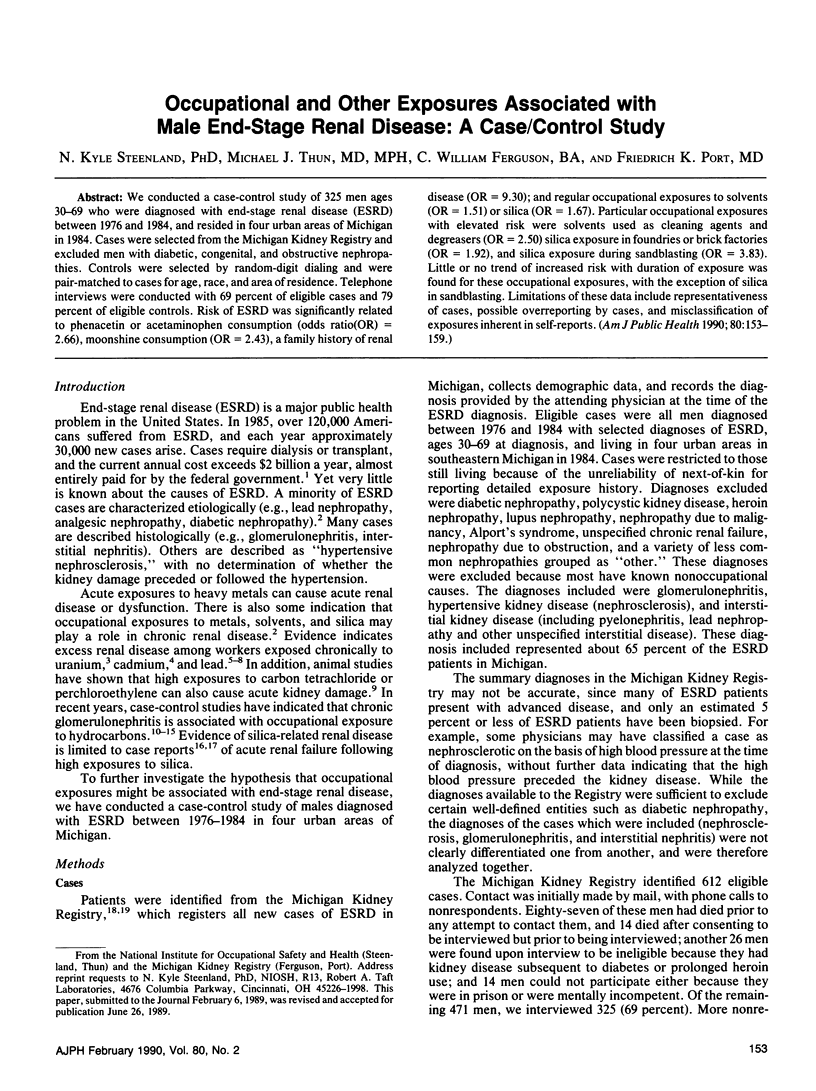
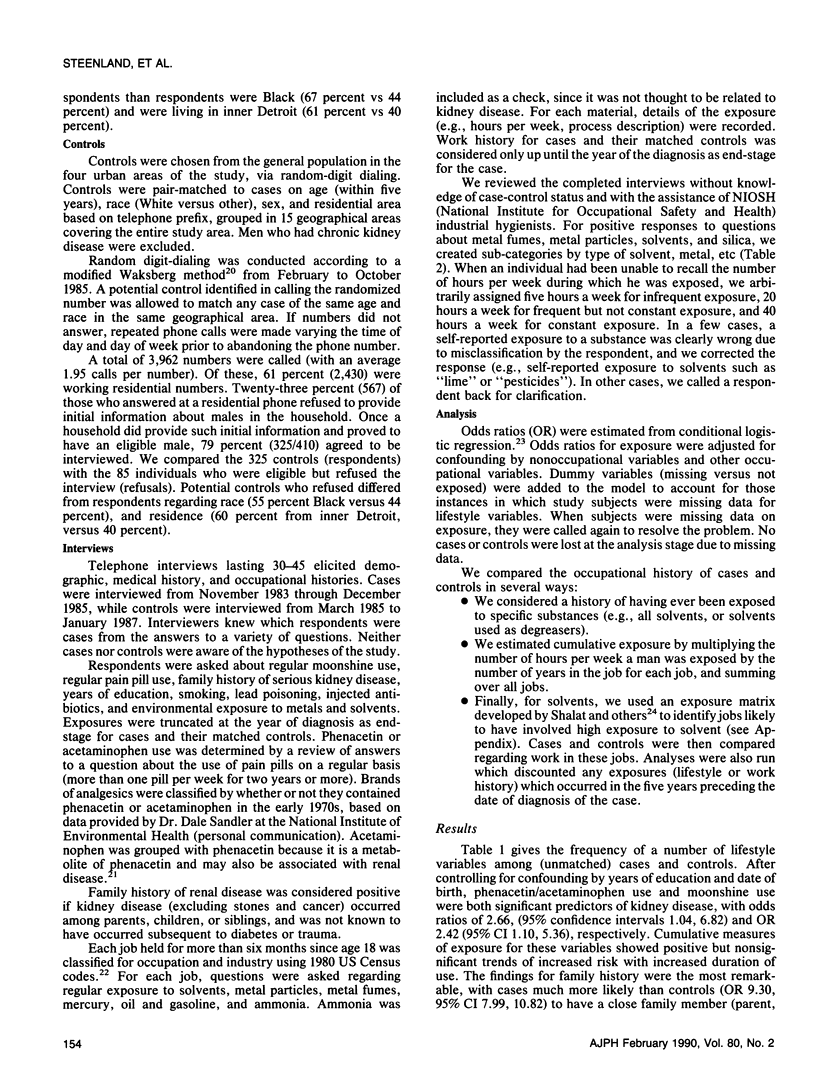
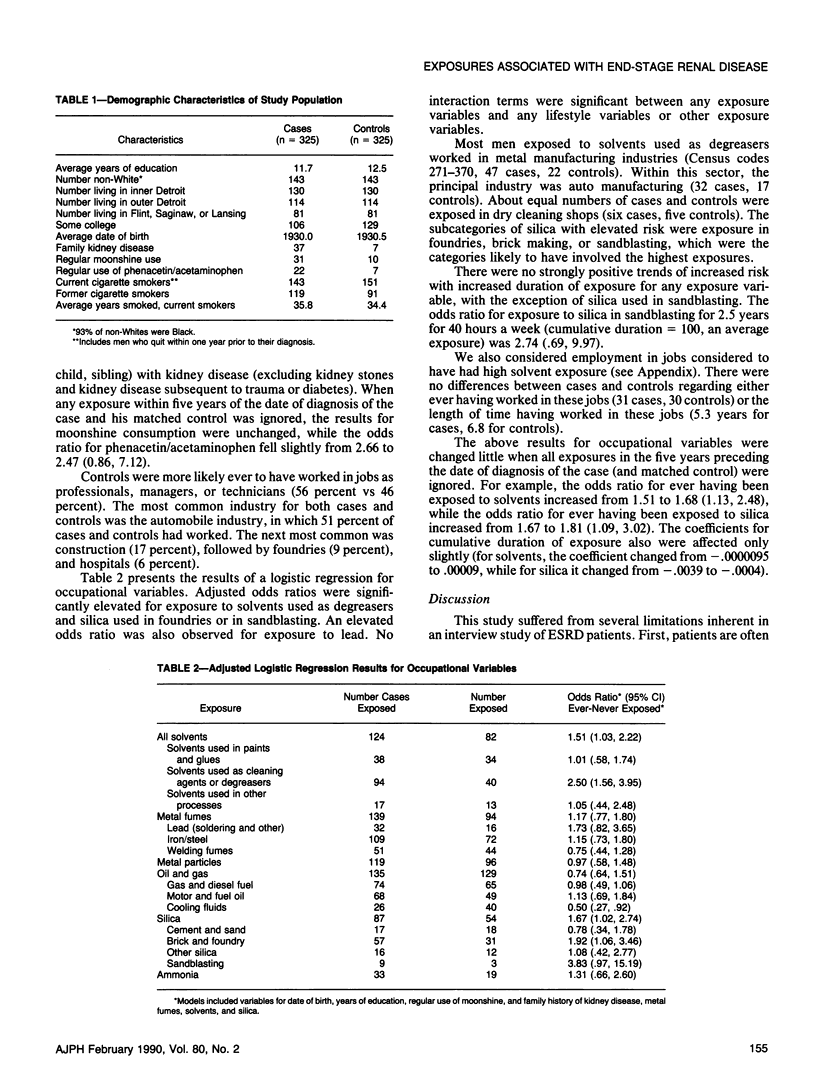
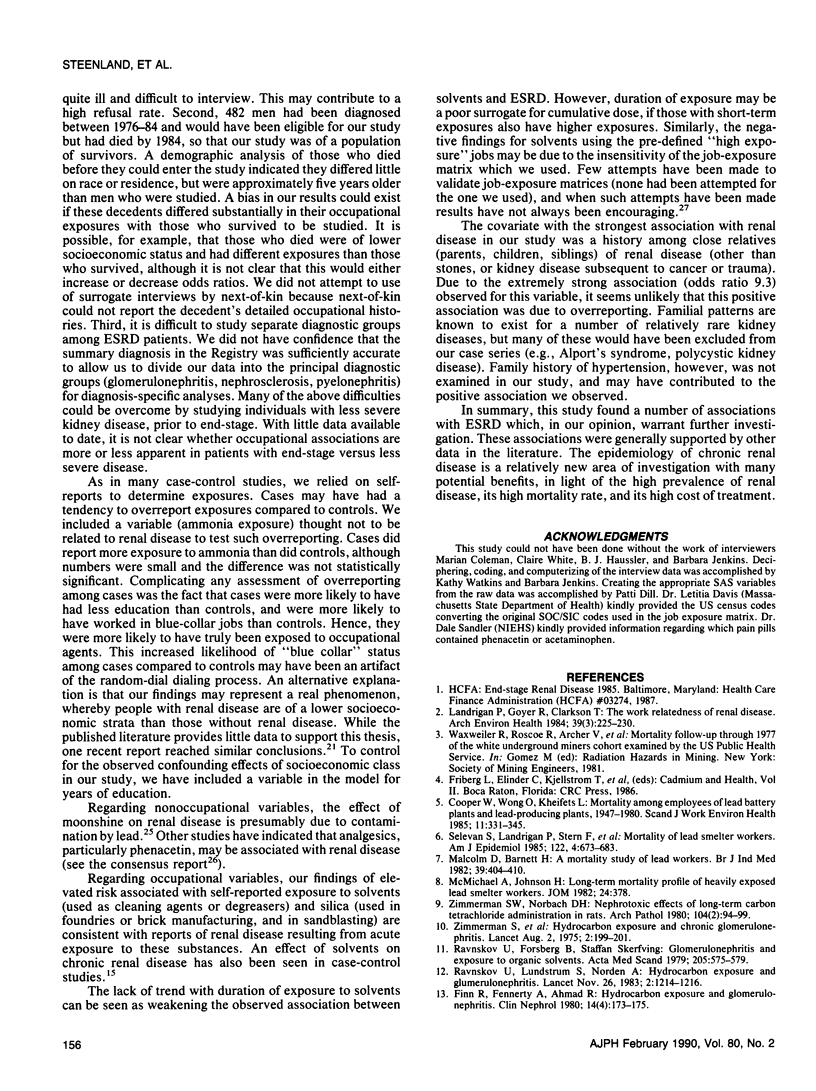
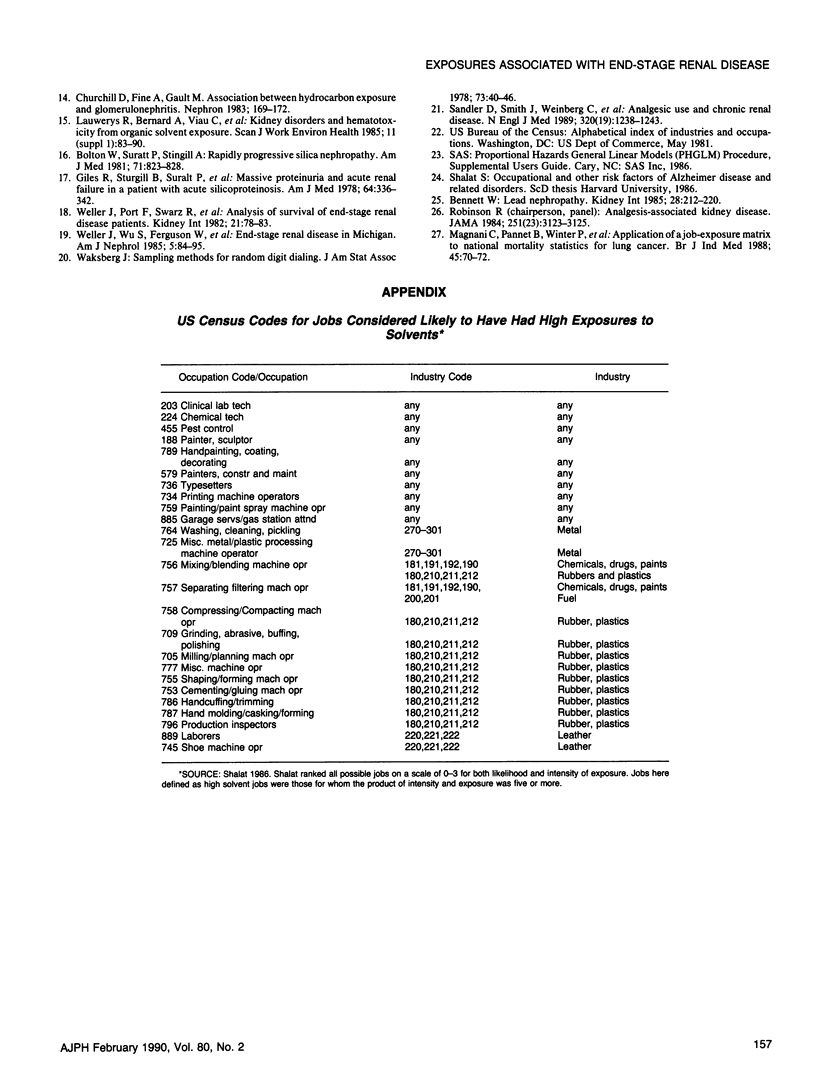
Selected References
These references are in PubMed. This may not be the complete list of references from this article.
- Bennett W. M. Lead nephropathy. Kidney Int. 1985 Aug;28(2):212–220. doi: 10.1038/ki.1985.143. [DOI] [PubMed] [Google Scholar]
- Bolton W. K., Suratt P. M., Strugill B. C. Rapidly progressive silicon nephropathy. Am J Med. 1981 Nov;71(5):823–828. doi: 10.1016/0002-9343(81)90374-0. [DOI] [PubMed] [Google Scholar]
- Churchill D. N., Fine A., Gault M. H. Association between hydrocarbon exposure and glomerulonephritis. An appraisal of the evidence. Nephron. 1983;33(3):169–172. doi: 10.1159/000182936. [DOI] [PubMed] [Google Scholar]
- Cooper W. C., Wong O., Kheifets L. Mortality among employees of lead battery plants and lead-producing plants, 1947-1980. Scand J Work Environ Health. 1985 Oct;11(5):331–345. doi: 10.5271/sjweh.2215. [DOI] [PubMed] [Google Scholar]
- Finn R., Fennerty A. G., Ahmad R. Hydrocarbon exposure and glomerulonephritis. Clin Nephrol. 1980 Oct;14(4):173–175. [PubMed] [Google Scholar]
- Giles R. D., Sturgill B. C., Suratt P. M., Bolton W. K. Massive proteinuria and acute renal failure in a patient with acute silicoproteinosis. Am J Med. 1978 Feb;64(2):336–342. doi: 10.1016/0002-9343(78)90063-3. [DOI] [PubMed] [Google Scholar]
- Landrigan P. J., Goyer R. A., Clarkson T. W., Sandler D. P., Smith J. H., Thun M. J., Wedeen R. P. The work-relatedness of renal disease. Arch Environ Health. 1984 May-Jun;39(3):225–230. doi: 10.1080/00039896.1984.9939529. [DOI] [PubMed] [Google Scholar]
- Lauwerys R., Bernard A., Viau C., Buchet J. P. Kidney disorders and hematotoxicity from organic solvent exposure. Scand J Work Environ Health. 1985;11 (Suppl 1):83–90. [PubMed] [Google Scholar]
- Magnani C., Pannett B., Winter P. D., Coggon D. Application of a job-exposure matrix to national mortality statistics for lung cancer. Br J Ind Med. 1988 Jan;45(1):70–72. doi: 10.1136/oem.45.1.70. [DOI] [PMC free article] [PubMed] [Google Scholar]
- Malcolm D., Barnett H. A. A mortality study of lead workers 1925-76. Br J Ind Med. 1982 Nov;39(4):404–410. doi: 10.1136/oem.39.4.404. [DOI] [PMC free article] [PubMed] [Google Scholar]
- McMichael A. J., Johnson H. M. Long-term mortality profile of heavily-exposed lead smelter workers. J Occup Med. 1982 May;24(5):375–378. doi: 10.1097/00043764-198205000-00008. [DOI] [PubMed] [Google Scholar]
- Ravnskov U., Forsberg B., Skerfving S. Glomerulonephritis and exposure to organic solvents. A case-control study. Acta Med Scand. 1979;205(7):575–579. doi: 10.1111/j.0954-6820.1979.tb06106.x. [DOI] [PubMed] [Google Scholar]
- Ravnskov U., Lundström S., Nordén A. Hydrocarbon exposure and glomerulonephritis: evidence from patients' occupations. Lancet. 1983 Nov 26;2(8361):1214–1216. doi: 10.1016/s0140-6736(83)91268-0. [DOI] [PubMed] [Google Scholar]
- Sandler D. P., Smith J. C., Weinberg C. R., Buckalew V. M., Jr, Dennis V. W., Blythe W. B., Burgess W. P. Analgesic use and chronic renal disease. N Engl J Med. 1989 May 11;320(19):1238–1243. doi: 10.1056/NEJM198905113201903. [DOI] [PubMed] [Google Scholar]
- Selevan S. G., Landrigan P. J., Stern F. B., Jones J. H. Mortality of lead smelter workers. Am J Epidemiol. 1985 Oct;122(4):673–683. doi: 10.1093/oxfordjournals.aje.a114146. [DOI] [PubMed] [Google Scholar]
- Weller J. M., Port F. K., Swartz R. D., Ferguson C. W., Williams G. W., Jacobs J. F., Jr Analysis of survival of end-stage renal disease patients. Kidney Int. 1982 Jan;21(1):78–83. doi: 10.1038/ki.1982.11. [DOI] [PubMed] [Google Scholar]
- Weller J. M., Wu S. C., Ferguson C. W., Hawthorne V. M. End-stage renal disease in Michigan. Incidence, underlying causes, prevalence, and modalities of treatment. Am J Nephrol. 1985;5(2):84–95. doi: 10.1159/000166912. [DOI] [PubMed] [Google Scholar]
- Zimmerman S. W., Groehler K., Beirne G. J. Hydrocarbon exposure and chronic glomerulonephritis. Lancet. 1975 Aug 2;2(7927):199–201. doi: 10.1016/s0140-6736(75)90671-6. [DOI] [PubMed] [Google Scholar]
- Zimmerman S. W., Norbach D. H. Nephrotoxic effects of long-term carbon tetrachloride administration in rats. Arch Pathol Lab Med. 1980 Feb;104(2):94–99. [PubMed] [Google Scholar]


